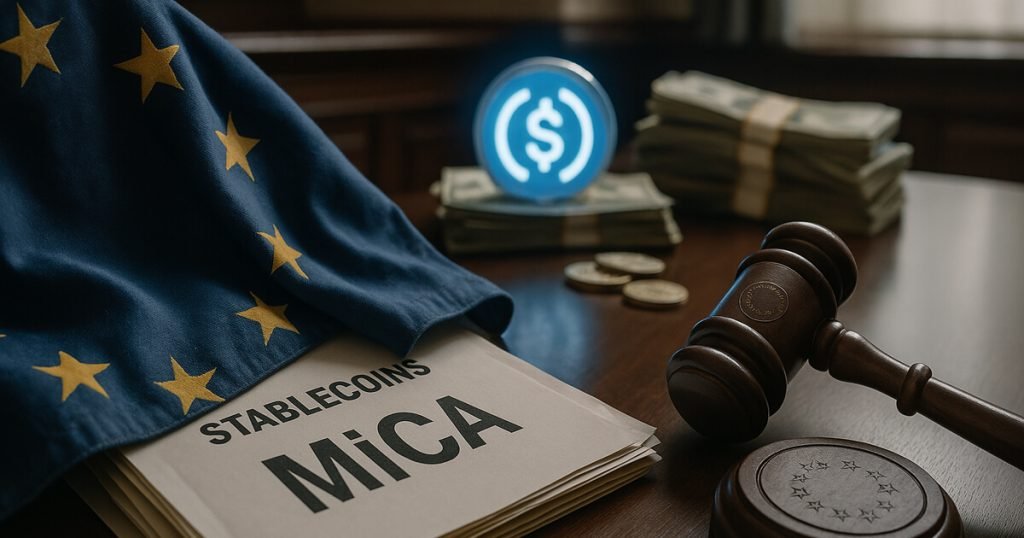The Impact of MiCA Regulation on Euro-Denominated Stablecoins and USD Dominance: A Critical Analysis
The European Union’s Markets in Crypto Assets (MiCA) regulation aims to establish clarity and safety within the cryptocurrency landscape, but it may inadvertently reinforce the dominance of the U.S. dollar over the euro in the realm of stablecoins. As the financial ecosystem increasingly embraces digital currencies, stablecoins have become integral to facilitating fast, transparent, and cross-border transactions. However, current trends show that more than 99% of stablecoins are pegged to the U.S. dollar. Unfortunately, instead of fostering euro-backed stablecoins, the MiCA regulation imposes restrictive requirements that limit their viability, ultimately enhancing USD’s standing within global finance.
The MiCA regulation’s restrictive nature on euro-denominated stablecoins demonstrates a clear misalignment in Europe’s ambitions. The EU, in its desire to promote innovation through a central bank digital currency (CBDC), has unintentionally created an environment where private euro-stablecoins struggle to coexist. Although the regulation attempts to project an image of safety by controlling stablecoins, its consequences lead to diminished private sector innovation in Europe. This regulatory framework plays into the hands of U.S. dollar stablecoins, which benefit from a more favorable and flexible environment conducive to innovation and competition. Thus, rather than challenging U.S. dollar supremacy, Europe’s regulatory approach appears to cement it further into the global financial landscape.
At a time when BRICS nations and even EU members strive to undermine the U.S. dollar’s dominance, the increasing use of stablecoins enhances the dollar’s position in global trade. As blockchain-based transactions gain traction across international borders, USD-backed stablecoins are set to play a crucial role in the financial ecosystem. Consequently, the failure to promote euro-stablecoins limits the euro’s competitive edge during a period where digital currencies are becoming increasingly relevant. As the race for dominance in the digital economy unfolds, the euro’s inability to present a robust alternative may hinder any efforts to challenge the dollar’s financial hegemony in the long run.
The misguided belief that a euro CBDC will enhance the euro’s global influence is one that overlooks critical lessons from history. Government-led financial initiatives often struggle to match the agility and innovation showcased by private-sector players. Moreover, a euro CBDC raises significant concerns about privacy and governmental oversight, stretching consumer autonomy. While the ambition behind a CBDC may seem appealing, the inherent limitations and the risks involved may ultimately undermine its intended purpose. In contrast, the U.S. strategy of nurturing private sector contributions through stablecoins represents a model that prioritizes swift market-driven progress, keeping innovation at its core.
Europe’s rigid stance on stablecoins through the MiCA framework signals a potential strategic error with profound geopolitical consequences. By thwarting private innovation in the realm of euro-stablecoins, Europe inadvertently bolsters USD dominance right when a competitive euro-backed alternative could emerge. Such a failure to recognize the importance of fostering innovation leads to the construction of a regulatory barrier that could render Europe increasingly irrelevant in the evolving financial landscape. With the rapid adoption of cryptocurrencies worldwide, capital, talent, and innovative minds will likely gravitate to regions that support and embrace experimental initiatives, leaving Europe at risk of falling behind in the next financial revolution.
To secure the future standing of the euro and challenge the dominance of USD stablecoins, Europe must reevaluate its regulatory stance. The future of finance hinges on empowering innovation rather than placing restrictions on it. If Europe continues down the path established by MiCA, it may inadvertently fortify the U.S. dollar’s grip on global finance. Only by creating a conducive environment for euro-backed stablecoins can the EU hope to enhance its financial sovereignty and play a significant role in shaping the future of money. As it stands, the implications of MiCA may ultimately serve to benefit the U.S. dollar more than any initiative designed to elevate the euro, potentially casting Europe as an observer rather than a contender in the digital currency race.


